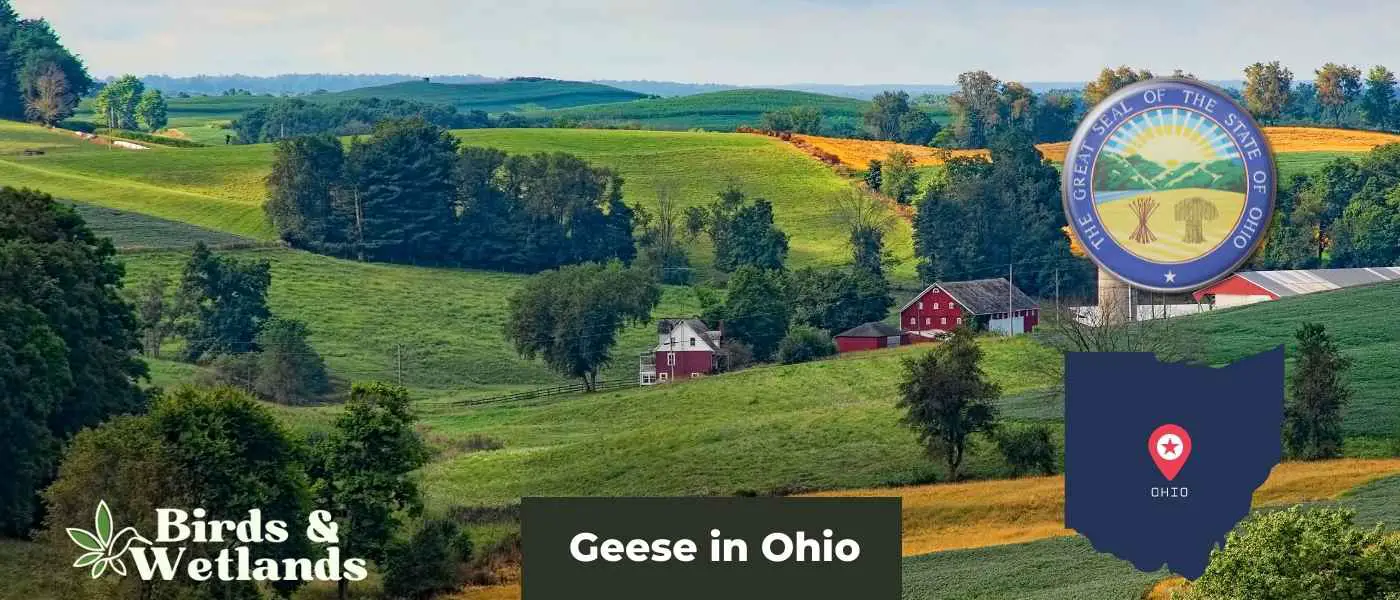If you’re a bird watcher or waterfowl hunter, you’ll be interested in knowing about the geese that are living in Ohio. There are several different species of geese that can be found here. In this blog post, we’ll take a closer look at some of the most common geese found in Ohio, and we’ll learn about what attracts them to our state.
What Geese Are in Ohio?
There are six species of geese living in Ohio.
- Canada Goose
- Snow Goose
- Ross’s Goose
- Cackling Goose
- Greater White-Fronted Goose
- Brant
Additionally, there are three species of swan in Ohio – Tundra Swan, Trumpeter Swan and Mute Swans.
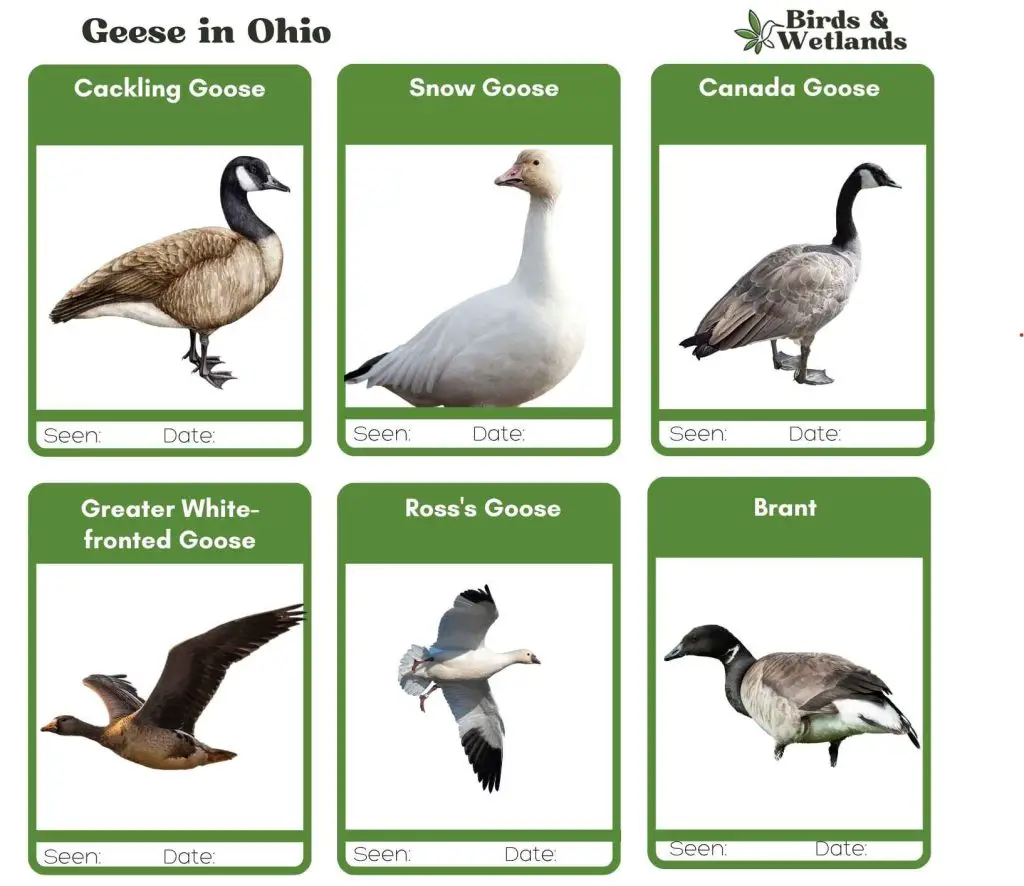
Canada Goose


Canada Goose Sound
Scientific Name: Branta canadensis
Length: 30 to 43 in
Wingspan: 50–73 in
Weight: 5.7–14.3 lb
The Canada Goose is a large, well-known species of waterfowl noted for its distinctive appearance, familiar “honk,” and migratory behavior.
Appearance: Both male and female Canada Geese have a similar appearance, featuring a black head and neck with distinctive white patches on the cheeks and chin. The body is primarily brown with a lighter, often white, underbelly.
Diet: Canada Geese primarily feed on plant matter, including grasses, aquatic vegetation, and grains. They can often be seen grazing in parks, lawns, and fields, as well as dabbling in water bodies.
Reproduction: Canada Geese typically nest on the ground near water bodies, often on islands or other isolated areas to avoid predators. The female lays a clutch of about 4 to 6 eggs, which she incubates alone for around a month.
Snow Goose

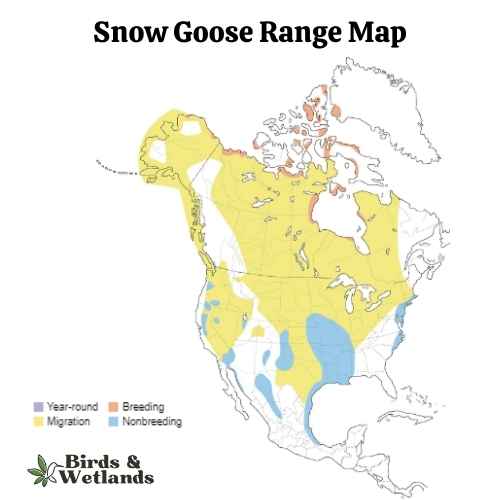
Snow Goose Sound
Scientific Name: Anser caerulescens
Length: 25 to 31 in
Wingspan: 53 to 65 in
Weight: 4.5 to 6.0
The Snow Goose is a large species of waterfowl known for its vibrant white plumage and significant migratory flights.
Appearance: True to their name, Snow Geese are predominantly white with black wingtips. They also have a pink bill, pink legs and feet. A color morph, known as the “Blue Goose,” displays a bluish-gray body with a white head, but is considered the same species.
Diet: Snow Geese primarily feed on plant matter, such as grasses, sedges, and small grains. They can often be seen in large flocks foraging in fields and marshes, and during migration and winter, they can cause considerable damage to agricultural fields due to their feeding habits.
Reproduction: Snow Geese typically nest on the tundra, near water bodies. The female builds the nest and lays a clutch of about 3 to 5 eggs, which she incubates alone for approximately three weeks. Once hatched, the goslings can feed themselves but stay with their parents for protection until they can fly.
Ross’s Goose
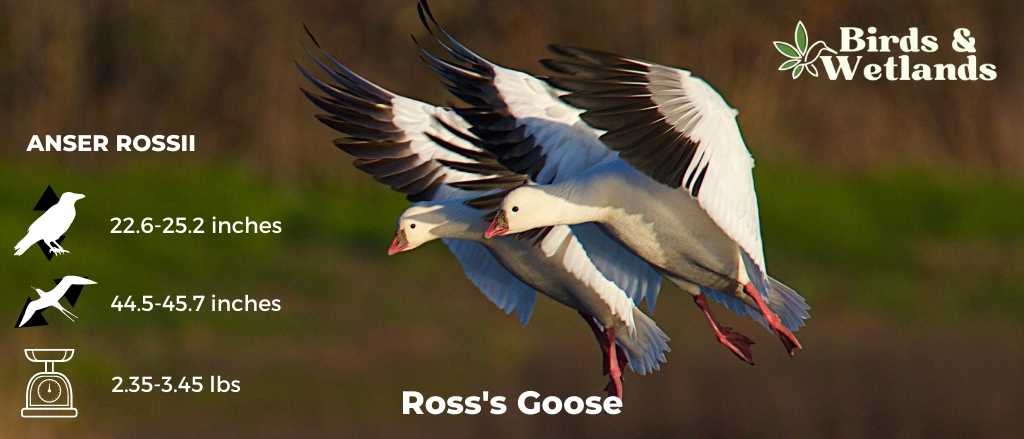
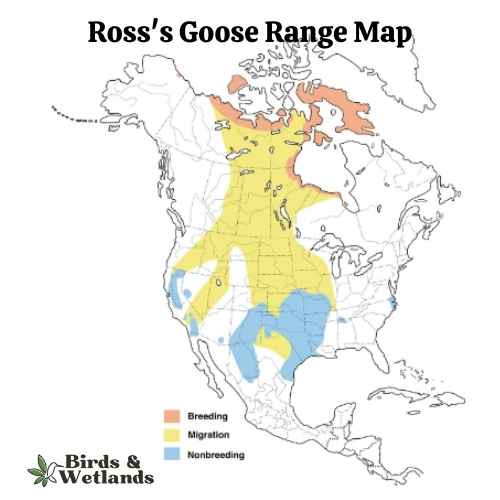
Listen
Scientific Name: Anser rossii
Length: 23.2-25.2
Wingspan: 44.5-45.7 in
Weight:42.3-55.3 oz
The Ross’s Goose is a small species of waterfowl often found in North America’s tundra and wetland habitats.
Appearance: Known for its compact size, the Ross’s Goose is mostly white with black wingtips. It features a short, stubby bill and a rounded head. One key identifying feature is the blueish gray base of its bill, which has a warty structure during the breeding season.
Diet: This goose feeds mainly on vegetation, including seeds, leaves, and roots of grasses and sedges. During winter and migration, they also consume grains and seeds from agricultural fields.
Reproduction: The Ross’s Goose nests on the ground, often in colonies. The female lays a clutch of 2 to 5 eggs which she incubates for around three weeks. The young geese, known as goslings, are precocial – they can walk, swim, and feed themselves shortly after hatching, although they stay with their parents until they learn to fly.
Cackling Goose
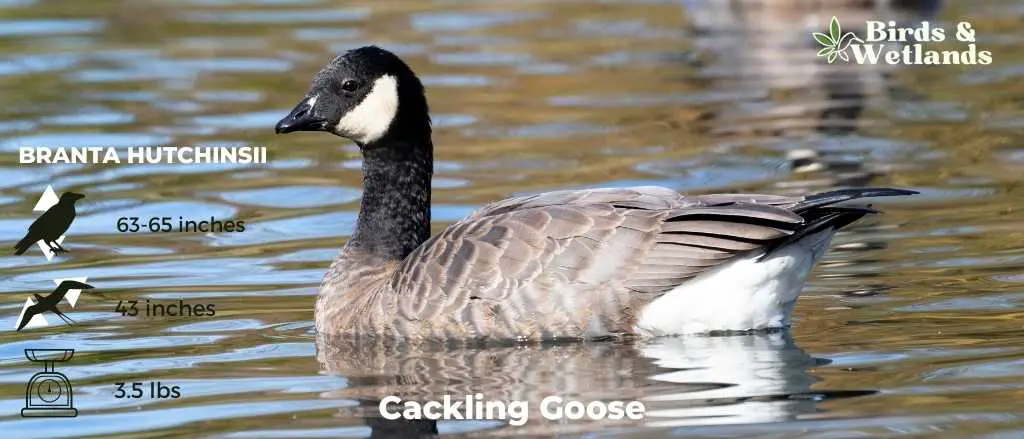
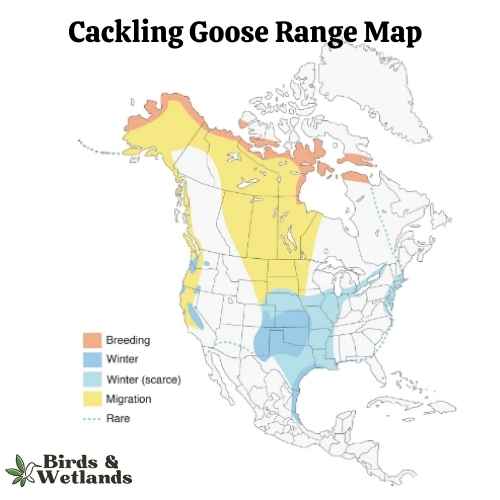
Listen
Scientific Name: Branta hutchinsii
Length: 24.8–25.6 in
Wingspan: 43-45.7 in
Weight:3.5 lbs
Cackling Geese are particularly known for their high-pitched, cackling calls, which is the source of their name. Despite their small size, these geese are renowned long-distance migrants, with some populations traveling thousands of miles between breeding and wintering grounds.
Appearance: With a similar color pattern to the larger Canada Goose, the Cackling Goose features a black head and neck, white chinstrap, light tan to cream chest, and brownish-grey body. One defining characteristic is its noticeably smaller size and stubbier neck compared to its larger counterparts.
Diet: Like many geese, the Cackling Goose’s diet mainly consists of plant matter. This includes grasses, seeds, and aquatic vegetation. They are often seen grazing on land or dabbling in shallow water.
Reproduction: Cackling Geese usually nest on the ground in elevated areas near water bodies, such as riverbanks or lakeshores. The female lays a clutch of 2 to 8 eggs and is responsible for incubation, while the male stands guard nearby. Incubation lasts for about a month.
Greater White-fronted Goose
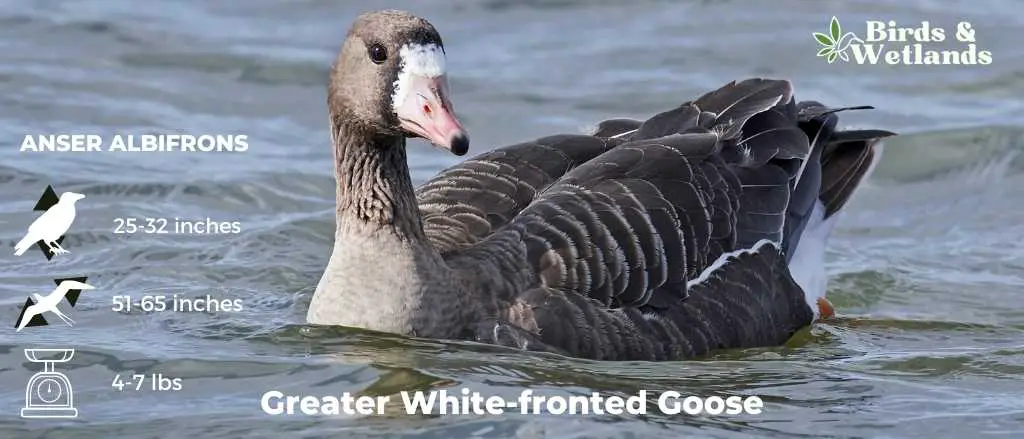

Listen
Scientific Name: Anser albifrons
Length: 25 to 31 in
Wingspan: 53 to 66 in
Weight: 3.3 to 6.6
The Greater White-fronted Goose is a medium to large waterfowl species, widely distributed across the Northern Hemisphere, particularly in North America.
Appearance: As the name suggests, these geese display a prominent white patch at the base of their bill. Their bodies are gray-brown, and their breasts are often marked with dark blotches. They possess a pinkish bill and orange legs and feet.
Diet: The Greater White-fronted Goose is a herbivore and feeds mainly on plant material. Its diet consists of grasses, sedges, grains, and berries. When wintering, these geese can often be found in agricultural fields, feasting on leftover grains and crops.
Reproduction: This species nests on the ground, often in areas with good visibility such as slopes or ridges. The female lays a clutch of 4 to 5 eggs, which she incubates for nearly a month. Once hatched, the young ones are taken care of by both parents until they are able to fly.
Brant

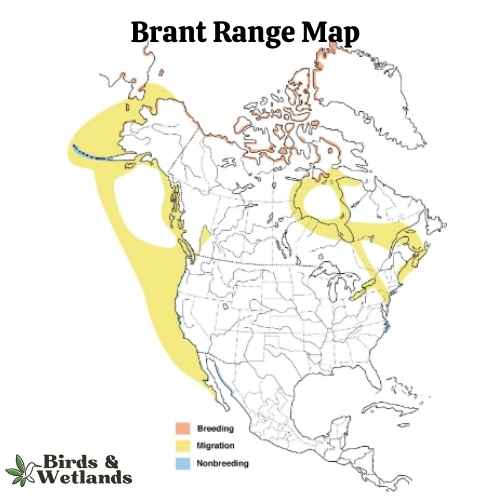
Listen
Scientific Name: Branta bernicla
Length: 22–26 in
Wingspan: 42–48 in
Weight: 1.9–4.9 lb
The Brant is a compact species of goose that is known for its striking appearance and interesting migratory patterns.
Appearance: The Brant is recognized for its dark, sooty color with a white crescent on the neck. The body is mostly black to dark gray, contrasting with the lighter underparts. Its small size, as compared to other geese, and short, stubby bill are other distinct features.
Diet: The Brant’s diet primarily consists of aquatic plants, especially eelgrass and sea lettuce. During the breeding season, they may also feed on grasses, sedges, and insects.
Reproduction: Brants typically breed in the high Arctic tundra. The female lays a clutch of 3 to 5 eggs in a ground nest, which she incubates for about a month.
Notably, Brants make an impressive long-distance migration every year. They spend their winters along both the east and west coasts of the United States and travel to the Arctic regions of Canada, Alaska, and even Russia to breed.
Where to Watch Geese in Ohio?
Ohio is home to many different types of wildlife, including several species of geese. If you’re looking for a place to watch these majestic birds, there are a few great locations to choose from. Killdeer Plains Wildlife Area is a great option if you’re looking to see a variety of wildlife, as it’s home to hundreds of species of birds including geese. Metzger Marsh Wildlife Area is another excellent choice, as it offers stunning views of Lake Erie. Magee Marsh Wildlife is yet another fantastic option, as it’s home to large flocks of migratory birds. No matter which location you choose, you’re sure to have an enjoyable experience watching the geese in Ohio.
Is There Any Resident Canada Geese in OH?
Ohio is home to a large population of resident Canada geese. These birds can be found in all 88 of the state’s counties, and they have nesting territories in the Lake Erie marshes and along the Ohio River. Resident birds are also pretty common near lakes, ponds and golf courses.
The state’s mild climate and abundance of food make it an ideal habitat for adult geese and young birds, and as a result, they have nesting sites all year-round in Ohio.
Many people considered resident geese a nuisance. Property owners are chasing geese away from their properties.
Hunting Geese in the state of Ohio
In order to hunt geese in Ohio, you need a valid hunting license, HIP certification, an Ohio Wetlands Habitat Stamp endorsement, and a federal Migratory Bird Hunting Stamp. You can purchase a hunting license at any authorized licensing agent or online at the Ohio Department of Natural Resources website.
Can You Shoot a Goose in Ohio?
In the state of Ohio, it is illegal to shoot geese with anything other than an approved nontoxic shot. The approved nontoxic shot includes steel, iron, tungsten-polymer, tungsten-matrix, bismuth-tin, lead-copper, and other shot types that have been deemed nontoxic by the U.S. Fish and Wildlife Service.
Additionally, the state of Ohio has daily bag and possession limits on goose hunting.
Where to Hunt Geese in Ohio?
Goose hunting in Ohio can be pretty good. Most of the best hunting is in the Lake Erie/Sandusky Bay area in the northwest and along the Ohio River in the south. The state has a healthy population of geese, and the birds are relatively easy to hunt. In general, geese can be found in open areas near water, such as marshes, fields, and lakes.
Is There a Goose Hunting Season in Ohio?
The goose hunting season in Ohio is from October to February.
Conclusion on Geese in the State of Ohio
If you’re ever in Ohio and see a goose, be sure to take some time to appreciate this interesting bird. Geese are fascinating creatures that have many unique adaptations that help them thrive in the Buckeye State.

